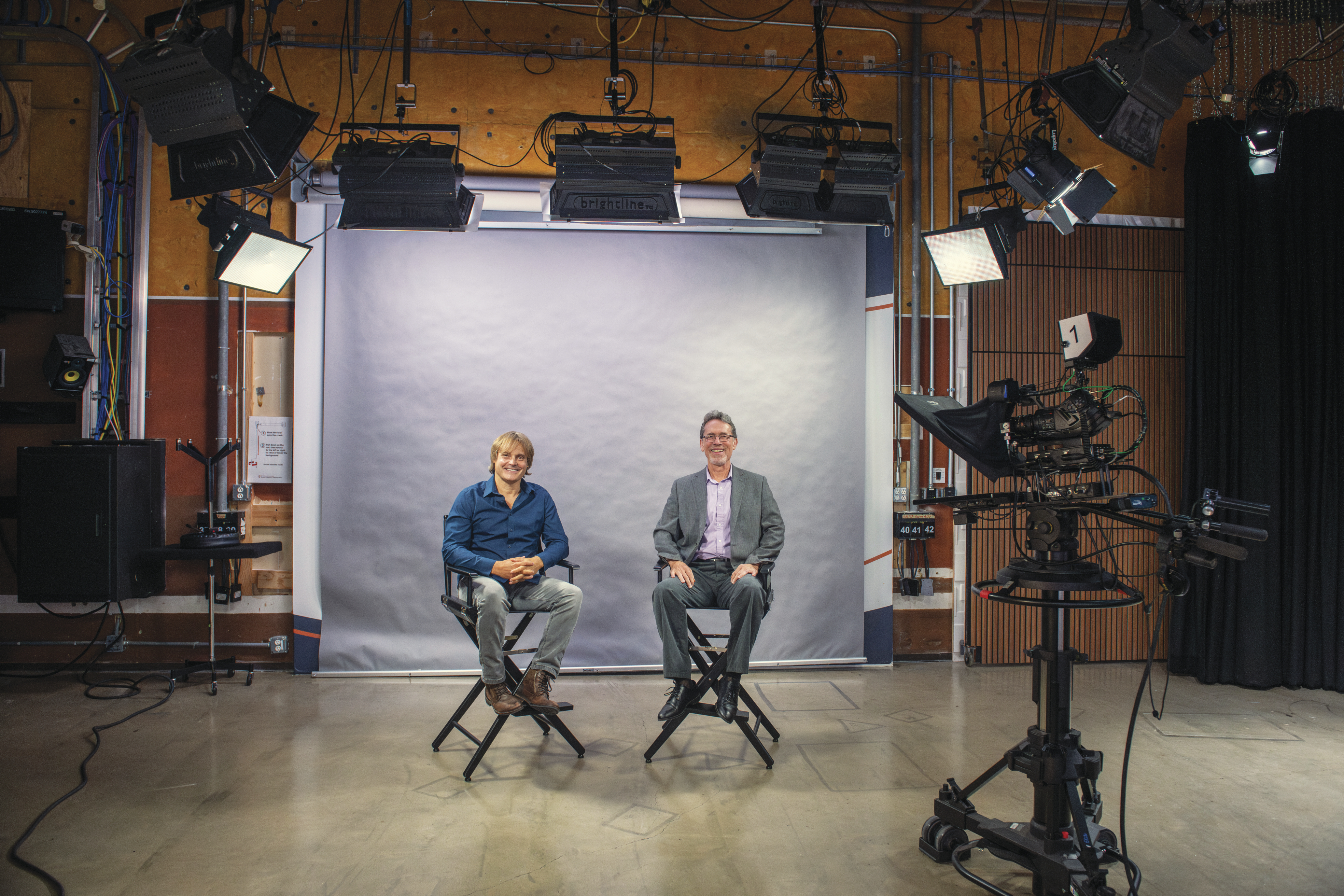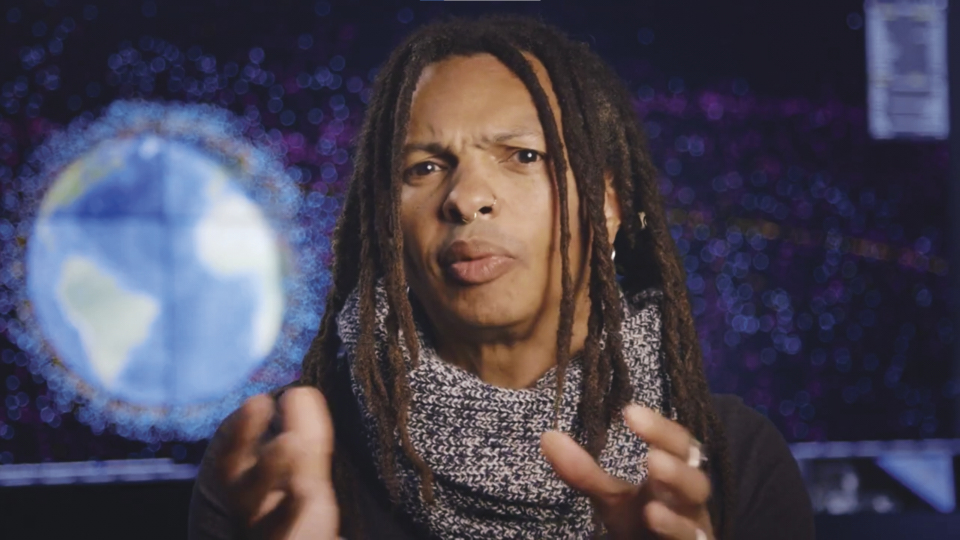Two Award-Winning Professors (and One Hollywood Celebrity) Make Science Cool

There’s no shortage of fun things to do on a Friday night in Austin. For many locals, from couples on date nights to retirees and wriggling kindergartners, the monthly “Hot Science – Cool Talks” event at The University of Texas at Austin is at the top of the list.
On a warm March evening, that’s where hundreds of Austinites have gathered, packing into Welch Hall to hear UT associate professor and astronomer
Caitlin Casey’s talk about how pictures of deep space from the James Webb Space Telescope are “breaking the universe”—or at least challenging scientists’ long-held theories about how it works.
“Hot Science” has been going strong for 25 years, with the free lecture series opening up the science on campus to a public audience. Most speakers are UT faculty members and researchers from across all scientific realms, from robotics to dinosaurs.
Jay Banner—the founder of “Hot Science,” the emcee at each talk, and a professor at the UT Jackson School of Geosciences—created the series to help people forge connections with the science and scientists around them. It’s been a hit since the very beginning. So many people showed up to the first talk in 1999 that they overflowed into the stairwells.
“We turned away more than 100 people who couldn’t fit in the room,” Banner says. “Then we knew there was an appetite for this, and it’s really just grown and grown from there.”
While filling auditoriums on the UT campus for more than two decades is an achievement on its own, Banner is now working to boil down the essence of the “Hot Science” experience—the scientific wonder and the personal connection—into a new television series called Hot Science TV.
The series is still in its early stages. There are currently six episodes, each one about seven minutes long, available for free online. Each episode showcases a “Hot Science” topic and speaker who, first and foremost, must be a great teacher.
This is something Banner knows all about. This year he received the Robert Foster Cherry Award for Great Teaching, one of the highest honors for teaching at the college and university level. The award is presented by Baylor University every two years and comes with a $250,000 prize for the winner and $25,000 for their home department. Recipients include English literature instructors, mathematicians, choral directors, and now, geoscientists. With such a wide variety of teachers entering the contest each cycle, choosing a winner comes down to evaluating who has had a transformational effect on students.
According to second-year undergraduate student Isha Bhasin, Banner’s engaging teaching style is why she is a geosciences student today. She became an environmental science major at the Jackson School after taking Banner’s course Sustaining a Planet as a first-year student. “He opened my eyes not only to what sustainability means,” Bhasin says, “but how it’s applicable in every part of our lives.”
The Cherry Award is also a reminder of how far he has come: According to Banner, he started out as a terrible teacher.
When he first joined the UT geosciences faculty in 1990, his teaching style could be politely described as maximalist. Banner said he tried to pack everything he learned in his own 16 years of post–high school education into one semester. He recalls completely misjudging his students’ reaction to this “more is more” approach.
“I can remember coming into the room one day with two full slide trays, swinging open the door, and the students turned and looked at me, and their eyes were really wide with what I thought at the time was wonderment,” Banner says. “But as I learned once I saw the reviews at the end of the semester, they were wide with either terror or hatred.”
On a recent field trip to Barton Springs and the surrounding Greenbelt, Banner’s pedagogical evolution was clear, as he engaged students in a discussion on aquifer recharge next to a looming limestone cliff eroded with holes. The class spent minutes watching a blue heron stalk its prey along the water’s edge.
Now, as Banner works to get Hot Science TV to bigger audiences, there are some parallels between the development of the show and his own teaching journey. Hot Science TV isn’t the first attempt to expand the reach of the “Hot Science” speakers through video. The current iteration of the program grew out of some unexpected advice—from the actor Adrian Grenier, a celebrity who has starred in numerous Hollywood projects including the early-2000s HBO hit Entourage.
Nowadays, in addition to acting, advocating for environmental causes, and working the land on his Bastrop farm, Grenier is a member of the Advisory Council of the UT Environmental Science Institute, which Banner directs.
During a council meeting about five years ago, Grenier said that if “Hot Science” was going to go big, simply taping the talks and uploading them online wasn’t going to cut it. “Hot Science” needed to be transformed from a long lecture into, as he puts it, “a little show.”
“They all have this amazing content on stage for people who are there, but what about all the people who can’t be there in person?” Grenier says, recounting the conversation at the meeting. “Why not make a show that people can access from afar?”
Banner agreed wholeheartedly. But this time, he would need some help.

That’s where Scott Rice, MFA ’03, and his team of Radio-Television-Film students come in. Rice is an Emmy Award–winning filmmaker and an associate professor of practice at UT’s Moody College of Communication, where he teaches the film production class Script to Screen with Matthew McConaughey, BS ’93, Life Member, Distinguished Alumnus. When Rice found out about Banner’s interest in turning the “Hot Science” lectures into a show, he said he was excited to work with his students to make it happen.
Each episode of Hot Science TV is shot in a single day, with students managing the scheduling, the set staging, and videography. All the footage is pieced together into a program where the speaker is talking directly to the camera.
“In this show, the scientist is the host. They speak directly to the viewer and express their particular passion for what they do, why they do it, and the heart behind it,” Rice says. “The heart element is very important. It’s the human element.”
Although film is a tough business, Rice is confident that the show has what it takes to be a success, with the program receiving positive reviews—particularly from K-12 teachers, whose students have always been a staple at the “Hot Science” lectures and critical to the success of the series.
“Each one of those speakers has nudged me toward being a better teacher,” Banner says. “I sit there, and I analyze, ‘Okay, this a great talk, what is it about it that’s making it so great, and how can I use that in my teaching?’”
That’s the thing about great teachers: They always keep learning.
CREDITS: From top, Sandy Carson; courtesy of Hot Science TV






